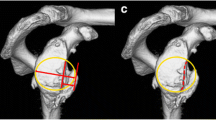Abstract
Objective
The purpose of this study is to describe the MR arthrogram appearance of the postoperative glenoid labrum and to describe the features consistent with recurrent tear.
Materials and Methods
We identified 30 patients who had undergone glenoid labral repair, had a subsequent MR arthrogram of his or her shoulder, and went on to repeat shoulder arthroscopy. Each MR arthrogram was reviewed blindly, and the glenoid labrum was described as normal, irregular, or torn. Additional findings recorded included the presence or absence of a paralabral cyst and suture anchors in the glenoid. The operative report was also reviewed for each patient to determine the status of the labrum at arthroscopy.
Results
Following consensus review, 18/30 MRIs were felt to demonstrate recurrent glenoid labral tear, 11/30 showed an irregular labrum, and 1/30 was called normal. The radiology impression regarding the presence or absence of a recurrent glenoid labral tear agreed with the operative report in 24/30 (80%) cases, and was discrepant in six. This equals 83.3% sensitivity and 81.8% specificity of MR arthrogram in the diagnosis of recurrent labral tear in this study. A paralabral cyst was present in 3/30 (10%) cases, all three of which were torn.
Conclusions
MR arthrogram findings of signal equal to gadolinium or fluid within or underlying the glenoid labrum and markedly diminutive or absent labrum were the most useful features to diagnose recurrent tear. Some signal underlying the labrum, which is confined to the anterosuperior quadrant, may be normal. The secondary finding of a paralabral cyst was also highly sensitive for recurrent tear.






Similar content being viewed by others
References
Mohana-Borges AV, Chung CB, Resnick D. MR imaging and MR arthrography of the postoperative shoulder: spectrum of normal and abnormal findings. Radiographics. 2004;24(1):69–85.
Park YH, Lee JY, Moon SH, et al. MR arthrography of the labral capsular ligamentous complex in the shoulder: imaging variations and pitfalls. AJR Am J Roentgenol. 2000;175(3):667–72.
Robinson G, Ho Y, Finlay K, Friedman L, Harish S. Normal anatomy and common labral lesions at MR arthrography of the shoulder. Clin Radiol. 2006;61(10):805–21.
Zlatkin MB. MRI of the postoperative shoulder. Skelet Radiol. 2002;31(2):63–80.
Chandnani VP, Yeager TD, DeBerardino T, et al. Glenoid labral tears: prospective evaluation with MRI imaging, MR arthrography, and CT arthrography. AJR Am J Roentgenol. 1993;161(6):1229–35.
Palmer WE, Brown JH, Rosenthal DI. Labral-ligamentous complex of the shoulder: evaluation with MR arthrography. Radiology. 1994;190(3):645–51.
Probyn LJ, White LM, Salonen DC, Tomlinson G, Boynton EL. Recurrent symptoms after shoulder instability repair: direct MR arthrographic assessment--correlation with second-look surgical evaluation. Radiology. 2007;245(3):814–23.
Wagner SC, Schweitzer ME, Morrison WB, Fenlin JM Jr, Bartolozzi AR. Shoulder instability: accuracy of MR imaging performed after surgery in depicting recurrent injury--initial findings. Radiology. 2002;222(1):196–203.
Bancroft LW, Wasyliw C, Pettis C, Farley T. Postoperative shoulder magnetic resonance imaging. Magn Reson Imaging Clin N Am. 2012;20(2):313–25. xi
Beltran LS, Bencardino JT, Steinbach LS. Postoperative MRI of the shoulder. J Magn Reson Imaging. 2014;40(6):1280–97.
Pierce JL, Nacey NC, Jones S, et al. Postoperative shoulder imaging: rotator cuff, labrum, and biceps tendon. Radiographics. 2016;36:1648–71.
Blankenbaker DG, De Smet AA, Keene JS. MR arthrographic appearance of the postoperative acetabular labrum in patients with suspected recurrent labral tears. AJR Am J Roentgenol. 2011;197(6):W1118–22.
Cardello P, Gigli C, Ricci A, Chiatti L, Voglino N, Pofi E. Retears of postoperative knee meniscus: findings on magnetic resonance imaging (MRI) and magnetic resonance arthrography (MRA) by using low and high field magnets. Skelet Radiol. 2009;38(2):149–56.
Gobexie R, Zurakowski D, Lavery K, Millett PJ, Cole BJ, Warner JJ. Analysis of interobserver and intraobserver variability in the diagnosis and treatment of SLAP tears using the Snyder classification. Am J Sports Med. 2008;36(7):1373–9.
Author information
Authors and Affiliations
Corresponding author
Ethics declarations
Conflict of interest
The authors declare that they have no conflict of interest.
Rights and permissions
About this article
Cite this article
Tiegs-Heiden, C.A., Rhodes, N.G., Collins, M.S. et al. MR arthrogram of the postoperative glenoid labrum: normal postoperative appearance versus recurrent tears. Skeletal Radiol 47, 1475–1481 (2018). https://doi.org/10.1007/s00256-018-2947-z
Received:
Revised:
Accepted:
Published:
Issue Date:
DOI: https://doi.org/10.1007/s00256-018-2947-z




